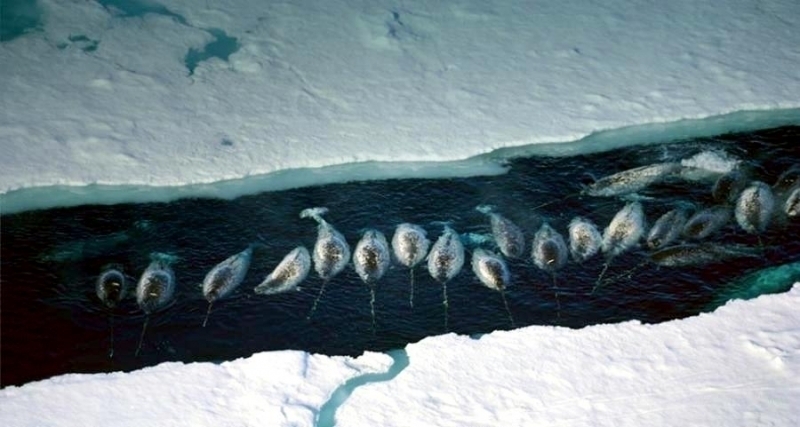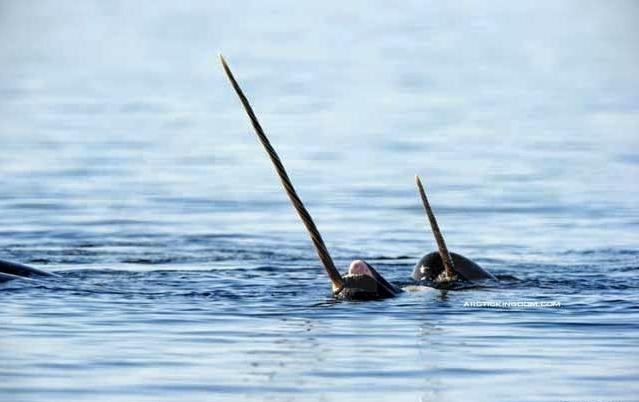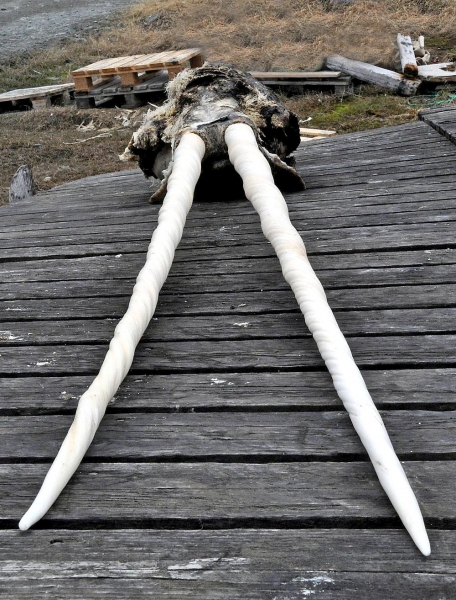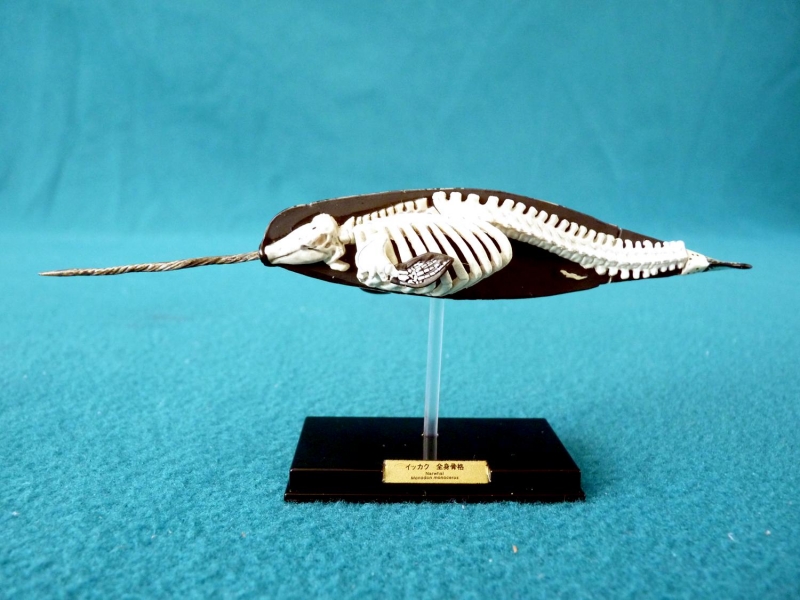“Monodon monoceros”
Narwhals are a gregarious species commonly found in pods of sometimes up to 20 individuals but most often in pods of 3 to 8, which are often segregated by sex. During the migratory season, smaller pods combine with other pods to form very large pods. Its name is derived from the old Norse word nár meaning “corpse” in reference to the animal’s grayish, mottled pigmentation like that of a drowned sailor and its summer-time habit of lying still at or near the surface of the sea called “logging”. Narwhals measure 3.6 to 6.2 meters in body length (average 4.7 meters in males, 4 meters in females) pectoral fins measure 30 to 40 centimeters tip to tip & width of the tail flukes is 1 to 1.2 meters. Average weight for a male Narwhal is 1,600 kilograms and 900 kilograms for females, about 1/3 of the weight consists of blubber. Compared to other cetaceans, Narwhals have a small head, blunt snout, short rounded flippers and convex rather than concave tail flukes. They have no dorsal fin, but they do have a ridge about 5 centimeters high that runs along the posterior end on the dorsal side that measures 60 to 90 centimeters long. Adult Narwhals are pale-gray or light-brown on the dorsal side, white on the ventral side, some with spotted patterns. Killer Whales & Polar Bears are the chief predators of Narwhals.
Narwhals have 2 teeth located in the upper jaw; in males, the left tooth will grow to form a long straight tusk, hence the nickname “Unicorn of the Sea”. The length of the tusk is between 1/3 to 1/2 as long as the length of the body. Tusks have measured up to 3 meters and weighed 10 kilograms. In rare cases, the other tooth forms a tusk, both of which grow counterclockwise in a spiral. Also in rare cases, females have been seen with tusks. The bottom end of the tusk appears clean & polished, however the remaining tusk is often covered in algae. The tusks are made up of an outer layer of cement, an inner layer calcareous hard tooth material called dentine and a pulp cavity rich in blood that holds the tusk in place. Narwhals often break tusks, however they are able to repair the damage with new dentin growth. The exact function of the tusk was unknown until recently and was thought to be used for male to male competition or to spear food or stir up food from the ocean bottom. The Narwhal’s tooth has hydrodynamic sensor capabilities. Ten million tiny nerve connections tunnel their way from the central nerve of the Narwhal tusk to its outer surface. Though seemingly rigid and hard, the tusk is like a membrane with an extremely sensitive surface capable of detecting changes in water temperature, pressure and particle gradients. Because these whales can detect particle gradients in water, they are capable of discerning the salinity of the water which could help them survive in their Arctic ice environment. It also allows Narwhals to detect water particles characteristic of the fish that constitute their diet. There is no comparison in nature and certainly none more unique in tooth form, expression and functional adaptation.
Narwhals live to over 50 years. They harbor several species of commensurable animals such as whale lice and certain nematodes. Narwhals are found in Arctic waters from eastern Canada to central Russia between 70°N-80°N. There are large concentrations in the Davis Strait, around Baffin Bay and in the Greenland Sea. They are occasionally found in eastern Siberia, Alaska and the western Canadian Arctic. They are an arctic species however, some wandering individuals have been seen of the coast of Newfoundland, Europe and the eastern Mediterranean. Narwhals are one of the northernmost cetacean species with a smaller range than other cetaceans. They tend to stay near the loose pack ice where they maintain breathing holes and prefer deep water, migrating with the seasonal advance and retreat of the ice. In the summer when ice cover is reduced in deeper water bodies, they migrate to smaller water bodies such as the heads of fjords. Narwhals feed on squid, fish, crustaceans & mollusks. Because they have few functional teeth, they are thought to use suction and jets of water to uncover prey on the ocean bottom. They have flexible necks that allow them to scan broad areas for food. The breeding habits of the Narwhal are largely unknown. It is known that they breed seasonally between March to May and give birth about 15 months later usually in July to August. Females are thought to nurse for about 20 months. Narwhals mate in the water belly to belly. Females give birth to a single calf most often, however in rare cases the birth of twins have been recorded. Calves are born tail first, measure 1.5 to 1.7 meters long, weigh 80 to 95 kilograms and are born with about a 25 millimeters thick layer of blubber.























































































